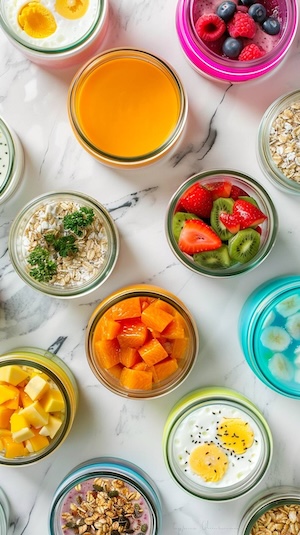Best Cereal for PCOS: Brands Ranked & Reviewed
Discover the best cereal for PCOS with our expert rankings. Compare brands, check ingredients, and find PCOS friendly cereal that supports hormonal balance.
How to make 3 kinds of cheongpomuk muchim, a traditional Korean side dish. The full recipe is on my website: http://www.maangchi.com/recipe/cheongpomuk-muchim Ingredients: Mung bean jelly: mung bean starch powder, water, salt Sauce: soy sauce, garlic, honey (or sugar), green onion, roasted sesame seeds, sesame oil Vegetables: edible chrysanthemum ("ssukgat" in Korean), Perilla leaves (can be replaced with basil leaves) Garnish: tomato, green chili pepper, red chili pepper, and laver Directions: 1.In a heavy-bottomed pot, place 1 cup of mung bean starch powder and 7 cups of water. Mix well with a wooden spoon. 2.Bring to a boil over medium high heat for about 7-8 minutes. *tip: Stir the liquid occasionally with the wooden spoon to stop it from sticking to the pot bottom 3. Add 1 ts of salt and cook for a few more minutes. *tip: total about 10 minutes cook over medium high heat 4. Lower the heat and simmer for 2-3 more minutes until the jelly looks bubbly and translucent. 5. Turn off the heat. Get out some rectangular containers and your favorite silicone cookie molds. 6. Pour the hot jelly directly into the containers and silicone cookie mold. 7. Let it cool down for 1-2 hours, then put it in the refrigerator. 8. Keep it in the refrigerator at least 4 hours to make the jelly firm and solid. Make sauce (yangnyeomjang) 1.Place 1/3 cup soy sauce, 1 ts honey(or 2 ts sugar), 3 cloves of minced garlic, 1 stalk of chopped green onion, and 1 TBS sesame oil into a bowl. Mix well. *tip: you can add hot pepper flakes if you want Are you ready to serve now? : ) 1.Take the jelly out of the refrigerator and cut it into bite size strips *tip: I usually cut it into strips ½" x 2″ x ½" or 2″ x 2½" x 1/3″ 2. Roast both sides of laver on your stove top. 3. Put the laver into a plastic bag. Crush it by rubbing the plastic bag with both hands. The first way to serve: 8-10 servings: 1.Put 4 cups of mung bean jelly strips (½" x 2″ x ½" ) into a bowl and add ¼ cup to 1/3 cup of the sauce. 2.Add 1 cup of edible chrysanthemum and a few perilla leaves, and about 3 tbs laver flakes. 3.Mix well and transfer it to a large plate. 4.Sprinkle some roasted sesame seeds over top and garnish with some shredded hot pepper (called shilgochu in Korean). *tip: In this video, I'm demonstrating how to make a beautiful rose with a tomato! The second way to serve: 1.Cut mung bean jelly into bite size pieces 2″ x 2½" x 1/3″. 2.Put it on a plate and add the sauce, sesame seeds, and laver flakes. 3.Garnish with chopped red chili pepper and green mint leaves. The third way to serve: 1.Take the bite size mung bean jelly pieces out of the silicone mold and put them into a small bowl. 2.Add the sauce, laver flakes, and sesame seeds to the top and garnish with shredded red pepper (shilgochu). FAQ: Q: Maangchi! How long can I keep the mung bean jelly in the refrigerator? A: You can keep it in the refrigerator up to 4-6 days! Q: Maaangchi, omg, the mung bean jelly that I made a couple of days ago has shrunk and the color looks milky. What shall I do, what shall I do? A: Haha, don't panic! : ) Boil some water in a pot and dump your milky jelly into the boiling water. Cook for a couple of minutes until it looks translucent again. It's more tasty than freshly made mung bean jelly in my experience! Q: Maangchi, I don't have laver now. Will it be still delicious without it? A: No, laver flakes are very essential to this dish. The flavor of roasted laver and the sauce and mung bean jelly really go with each other. Q: I don't have shredded red pepper. Can I skip it? A: Yes, you can! Forget about the damn shredded red pepper! : )
This recipe includes superfoods such as:
Transform your health with tailored 7-day meal plans designed specifically for PCOS management. Just $7/month or $59/year.
Get it now →See video for ingredients
See video for instructions

You know the drill: Alarm goes off. You hit snooze. Rush around frantically. Skip breakfast AGAIN because there's no time. By 10am, you're hangry, your blood sugar is all over the place, and your PCOS symptoms are already acting up.
Sound familiar?
Finally – a meal prep system designed specifically for women with PCOS who refuse to let chaotic mornings derail their health goals.
In just ONE hour on Sunday, you can transform your entire week:
"I went from skipping breakfast 4 days a week to having delicious, hormone-supporting meals ready every morning. My energy is more stable and my cravings have disappeared!"
– Sarah M.
Stop letting chaotic mornings control your health.
Get your hormone-happy mornings starting this Sunday.
→ Get Your 60-Minute Solution Now
Transform your health with tailored 7-day meal plans designed specifically for PCOS management. Just $7/month or $59/year.
Get it now →Serving Size: 0
| Amount Per ONE Serving | ||
|---|---|---|
| Calories 0 kcal | ||
| Fat 0 g | ||
| Carbohydrate 0 g | ||
| Protein 0 g | ||
💡 Introducing the 10/10 PCOS Solution:
Ten Delicious Crockpot Recipes that take just 10 minutes to prep!
Say goodbye to hours in the kitchen and hello to clean, PCOS-friendly meals made effortlessly.
👉 Click here to grab your 10/10 PCOS Solution today! Try The 10/10 PCOS Solution: Ten Crockpot Recipes That Take Just Ten Minutes to Prep
Managing PCOS can be challenging, but you don't have to do it alone. Join our supportive community to connect with others who understand what you're going through, share tips, and get encouragement. Here's how you can get involved:
Subscribe to our Newsletter: Receive PCOS-friendly recipes, tips, research updates, and more delivered straight to your inbox. Stay informed and empowered with the latest information and support.
Join our Telegram Channel: Stay updated with the latest tips and advice on managing PCOS.
Follow PCOS Meal Planner on Facebook: Engage with our community, participate in discussions, and get support from others.
Break the cycle with the PCOS Meal Planner - your personalized guide to eating better, feeling better, and managing PCOS symptoms. Take control today!

Forget the frustrating cycle of weight loss attempts, endless medications, and living in discomfort. Introducing the PCOS Meal Planner. A meal planning guide that goes beyond temporary fixes to offer a comprehensive strategy, empowering you to ignite a transformation towards lasting health and happiness. Step into a world where you control your PCOS, not the other way around.
Unlock Your PCOS Freedom Now.
Discover the best cereal for PCOS with our expert rankings. Compare brands, check ingredients, and find PCOS friendly cereal that supports hormonal balance.
Learn how to transition away from fruit when starting a ketogenic diet for PCOS. Discover gradual strategies, fruit alternatives, and practical tips for success.
Discover 5 delicious PCOS banana bread recipes with low-glycemic ingredients. Learn how to make hormone-friendly banana bread that supports blood sugar balance.
Creatine for women with PCOS explained simply. Learn safety, benefits, hormone effects, tips, and how creatine may support PCOS symptoms naturally.
Complete PCOS diet plan with foods to eat, foods to avoid, meal timing, and real results. Learn the science-backed approach to managing PCOS through diet, with 7-day meal plan, grocery list, and step-by-step implementation guide. Based on clinical research and real patient outcomes.
Complete guide to ordering at Wendy's with PCOS. Discover the best protein-focused meals, what to skip, and how to customize orders to keep blood sugar stable. Learn which burgers, salads, and sides work for PCOS, plus complete macros for every menu item and smart swaps to avoid insulin spikes.
Complete guide to ordering at Burger King with PCOS. Discover the best protein-focused meals, what to skip, and how to customize orders to keep blood sugar stable. Learn which burgers, salads, and sides work for PCOS, plus complete macros for every menu item and smart swaps to avoid insulin spikes.
Discover 30+ delicious PCOS-friendly smoothie recipes that stabilize blood sugar and support hormones. Each recipe includes protein macros, glycemic load, and hormone-balancing ingredients. Find breakfast smoothies, post-workout options, green smoothies, and dessert alternatives - all designed to prevent insulin spikes while satisfying cravings.
Discover the best supplements for PCOS backed by clinical research. Learn which supplements improve insulin resistance, reduce androgens, support ovulation, and balance hormones. Complete guide with dosages, timing, brands, and what to avoid. Evidence-based recommendations for inositol, vitamin D, omega-3, berberine, and more.